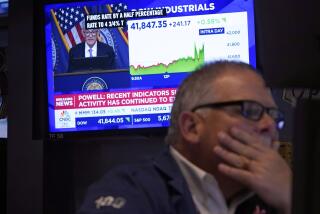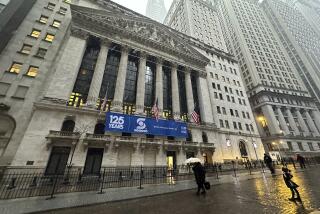Dollar Continues Comeback After Fed Statement
The dollar continued to reassert itself in currency markets Thursday, one day after the Federal Reserve may have signaled that higher U.S. interest rates were on the horizon.
Gold, which had been a major beneficiary last year of the dollar’s weakness, suffered its biggest one-day drop in six years.
The dollar’s rebound was most pronounced against the euro, which ended at $1.241 -- down from $1.248 on Wednesday and $1.263 on Tuesday. The euro had peaked at $1.28 on Jan. 9.
The buck gained more modestly against other key rivals, including the Canadian dollar, the Swiss franc and the British pound. But it lost ground against the Japanese yen.
The dollar has been hammered over the last year, particularly relative to the euro, as traders have found all sorts of reasons to bet that the U.S. currency would continue to be cheapened. Factors weighing on the dollar have included the huge U.S. trade and budget deficits and the Federal Reserve’s rock-bottom short-term interest rates.
But the dollar’s downward momentum was broken about two weeks ago, when some European finance ministers hinted that they might take action to keep the euro from strengthening further. The euro’s surge from $1.08 a year ago has been hurting European exporters by making their products more expensive for U.S. buyers.
When Fed policymakers on Wednesday tweaked the language in the official statement after their first meeting of 2004 -- saying they could “be patient” with low interest rates, a change from the pledge of recent months to keep rates low for a “considerable period” -- many currency traders took it as another sign that the dollar’s decline may have halted, at least temporarily.
In theory, higher interest rates could pull more foreign capital into U.S. bonds, bolstering the dollar.
“The sense that [rates] could go higher sooner rather than later has caused people to rethink a bit some of their shorter-term currency plays,” said John McCarthy, director of foreign exchange at ING Capital Markets in New York.
Others said the dollar’s rally would be short-lived.
“Once the dust does settle and the market recognizes the Fed is not going to rush headlong into raising rates, that will support” the euro, said Ian Gunner, head of foreign exchange at Mellon Financial Corp. in London.
The next inflection point for currencies may be the two-day meeting of the Group of 7 industrialized nations’ finance ministers and central bankers that begins Feb. 6.
Many experts say the Bush administration still seems intent on allowing the dollar to fall further to aid U.S. exporters.
As long as the dollar is rebounding, it could be bad news for gold. The metal had rallied sharply last year as the falling dollar made gold cheaper for foreign buyers. Gold is priced in dollars worldwide.
On Thursday, near-term gold futures in New York plummeted $16.10, or about 3.9%, to $398.50 an ounce, the lowest since Nov. 26. It was the largest one-day decline since October 1997.
Besides the dollar’s rally, worries about potential central bank gold sales also hurt the metal.
The German central bank reiterated Thursday that it wanted to join other central banks in selling more gold if the 1999 European accord governing bank sales was renewed.
But Japan’s finance minister on Wednesday said his government might consider buying gold to add to the nation’s reserves, which are relatively low compared with other nations.
More to Read
Inside the business of entertainment
The Wide Shot brings you news, analysis and insights on everything from streaming wars to production — and what it all means for the future.
You may occasionally receive promotional content from the Los Angeles Times.










